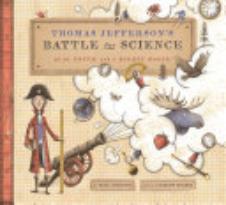Logic
10 Reviews
(1)
K-3
Illustrated by
Jeremy Holmes.
As a product of the Age of Reason, Thomas Jefferson was long fascinated by science in general and the natural world in particular. Consequently, when he first read a French encyclopedia by the renowned scientist Comte de Buffon that declared the American colonies inferior because the native animals were neither as large nor as ferocious as their European counterparts, Jefferson questioned Buffon's reasoning -- partly because of the audacious comments, partly because of national pride, and partly because Jefferson did not want to discourage immigration. For years he challenged these assumptions by asking questions; creating counterarguments; conducting experiments (which included the shipping of a dead moose to France to verify its large size); and formulating and publishing his conclusions. In other words, he followed the scientific method, nicely summarized in the back matter. The mixed-media illustrations, crafted with woodblocks and pencil, are highlighted in unusual and effective layouts. The written narrative appears in text boxes, acting either as previews for the often-humorous illustrations (for example, ideas explode from Jefferson's head as he writes his own book challenging Buffon) or as comic panels. A concluding author's note explains the sources and dangers of misinformation and ways to identify and combat such rumors, as well as a timeline of Jefferson's life and a bibliography -- appropriately, for the topic -- divided into primary and secondary sources.
Reviewer: Betty Carter
| Horn Book Magazine Issue:
May, 2024
(4)
4-6
Instead of arriving at Camp Vermeer for a week-long summer art program, soon-to-be eighth grader Esther finds herself at Camp Archimedes--stuck with "math nerds"--thanks to torrential rain, car trouble, and her stepfather's lousy navigation. But Esther soon proves she's a number-cruncher, too, tackling a logic puzzle about a killer named "Sphinx." Offbeat secondary characters blur together in this otherwise entertaining ambitious math and mystery combo.
Reviewer: Tanya D. Auger
(3)
K-3
Illustrated by
Eric Comstock.
It's 3:30 p.m., and Charlie Piechart--just a regular kid with a pie chart for a torso--must find his dog in time for a 4:15 groomer's appointment. As in the previous Charlie Piechart books, the boy sleuth arms himself with math and logic. It's a compelling educational caper, with winning throwback art in retro colors like mustard and aqua.
Reviewer: Nell Beram
(3)
4-6
Brain Game Treasure Hunts series.
Each book contains ten challenging illustrated puzzles (numeric and geometric puzzles, mazes, codes, patterns revealing words, etc.) in the context of a themed adventure. Math skills, logic, and spatial manipulation are required for readers to safely "return" to their starting places. One appended section provides hints to puzzle solutions; a separate section provides the actual solutions. Ind. Review covers the following Brain Game Treasure Hunts titles: Jungle Puzzles, Ocean Puzzles, Pyramid Puzzles, and Space Puzzles.
Reviewer: Gail Hedges
(3)
4-6
Brain Game Treasure Hunts series.
Each book contains ten challenging illustrated puzzles (numeric and geometric puzzles, mazes, codes, patterns revealing words, etc.) in the context of a themed adventure. Math skills, logic, and spatial manipulation are required for readers to safely "return" to their starting places. One appended section provides hints to puzzle solutions; a separate section provides the actual solutions. Ind. Review covers the following Brain Game Treasure Hunts titles: Jungle Puzzles, Ocean Puzzles, Pyramid Puzzles, and Space Puzzles.
Reviewer: Gail Hedges
(3)
4-6
Brain Game Treasure Hunts series.
Each book contains ten challenging illustrated puzzles (numeric and geometric puzzles, mazes, codes, patterns revealing words, etc.) in the context of a themed adventure. Math skills, logic, and spatial manipulation are required for readers to safely "return" to their starting places. One appended section provides hints to puzzle solutions; a separate section provides the actual solutions. Ind. Review covers the following Brain Game Treasure Hunts titles: Jungle Puzzles, Ocean Puzzles, Pyramid Puzzles, and Space Puzzles.
Reviewer: Gail Hedges
(3)
4-6
Brain Game Treasure Hunts series.
Each book contains ten challenging illustrated puzzles (numeric and geometric puzzles, mazes, codes, patterns revealing words, etc.) in the context of a themed adventure. Math skills, logic, and spatial manipulation are required for readers to safely "return" to their starting places. One appended section provides hints to puzzle solutions; a separate section provides the actual solutions. Ind. Review covers the following Brain Game Treasure Hunts titles: Jungle Puzzles, Ocean Puzzles, Pyramid Puzzles, and Space Puzzles.
Reviewer: Gail Hedges
(3)
4-6
Brain Benders series.
Number puzzles, riddles, coin games, card tricks, mazes, and other engaging brain teasers encourage readers to practice and refine their logical thinking, visualization, and numeracy skills. Classic problems pop up, including the river crossing challenge, matchstick puzzles, and cube folding. Some puzzles require common household items (e.g., dice, scissors, spaghetti). Helpful hints and answers are appended to the straightforward text and clear visuals. Ind. Review covers these Brain Benders titles: It's Only Logical, Not So Ordinary, and Think Outside the Box.
Reviewer: Tanya D. Auger
(3)
4-6
During the four years his detective father is in a coma, Darkus Knightley memorizes all his cases. When his dad unexpectedly awakens, the two team up to investigate the Combination, a shadowy criminal organization, and The Code, a book that prompts ordinary people to commit crimes. Set in modern-day London, Gavin's series-opener has an entertaining Holmes-ian influence and enjoyably quirky characters.
Reviewer: Tanya D. Auger
(4)
K-3
Illustrated by
Sherry Rogers.
A duck detective eliminates one animal suspect after another until he "quacks the case," deducing who stole a cake from a cake contest. In this story designed to introduce deductive reasoning, bad puns and misfired jokes get in the way of the narrative's agenda. The boldly colored illustrations will draw readers into the lesson. Two reasoning activities are appended.
Reviewer: Sophie Williamson
10 reviews
We are currently offering this content for free. Sign up now to activate your personal profile, where you can save articles for future viewing.













